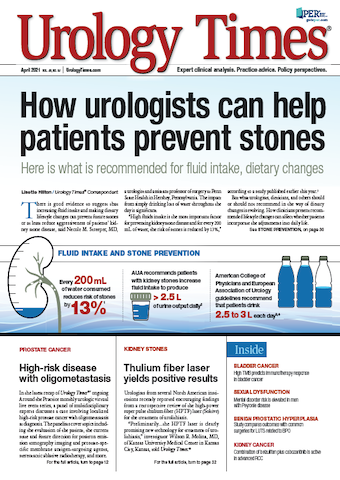Publication
Article
Urology Times Journal
Study compares outcomes with common surgeries for LUTS related to BPO
Author(s):
A comparative study of 5-year surgical reintervention rates in patients with lower urinary tract symptoms (LUTS) due to benign prostatic obstruction (BPO) showed that compared with transurethral resection of the prostate (TURP), photoselective vaporization of the prostate (PVP) had a significantly higher reintervention rate, while open simple prostatectomy (OSP) had a significantly lower reintervention rate.1
The retrospective study, which was conducted by researchers in Germany, compared reintervention rates in the 4 standard surgical interventions for BPO-related LUTS: TURP, OSP, PVP, and laser enucleation of the prostate (LEP). Regarding LEP, there was no difference in overall reintervention rates observed between the treatment and TURP.
“The surgical reintervention rate after surgery for LUTS due to BPO is a robust criterion of the quality of treatment,” the authors wrote. “Open simple prostatectomy remains superior to transurethral resection with respect to long-term efficacy.”
For their study, the researchers examined claims data from AOK, the largest provider of statutory health insurance in Germany. Overall, the study data was compiled from the records of 43,041 male patients with LUTS. Between 2011 and 2013, the patients were treated with TURP (n = 34,526), OSP (n = 3651), PVP (n = 3050), or LEP (n = 1814).
Across the total study population, the median age was 72 years (interquartile range, 66-77). The extent of comorbidity varied between the treatment-defined patient subgroups, with the highest degree of comorbidity in patients treated with PVP.
Overall, within 5 years of primary surgery, there were 5050 first reinterventions performed. Statistical modeling showed that relative to TURP, there was an increased hazard of reintervention with PVP (HR, 1.31; P <.001); in contrast, the hazard of reintervention was significantly lower with OSP compared with TURP (HR, 0.43; P <.001). When specifically focusing on LUTS recurrence, these hazard data were further amplified: PVP versus TURP (HR, 1.52; P <.001), and OSP versus TURP (HR, 0.38; P <.001).
The researchers also evaluated reinterventions for urethral stricture and bladder neck contracture. With these reinterventions, the hazards for PVP and TURP did not vary, while OSP again had a significantly lower hazard than TURP (HR, 0.45; P <.001).
Some of the potential limitations of the study noted by the researchers were the use of data from a single provider; the inherent limitations of a retrospective analysis; and the lack of extensive clinical information provided on claims data.
In their concluding remarks, the authors stressed the significance of the long follow-up period captured by their data. “To our knowledge, this is the only study to date with a 5-year follow-up for the 4 most established approaches in LUTS surgery,” the authors wrote. “Our findings underline the importance of long-term studies, since a continuous increase in reinterventions was evident up to the fifth year from initial surgery for all 4 approaches.”
Reference
1. Gilfrich C, May M, Fahlenbrach C, et al. Surgical reintervention rates after invasive treatment for lower urinary tract symptoms due to benign prostatic syndrome: a comparative study of more than 43,000 patients with long-term follow-up. J Urol. 2021 Mar;205(3):855-863. doi: 10.1097/JU.0000000000001463


























2 Commerce Drive
Cranbury, NJ 08512
All rights reserved.






